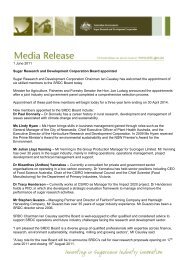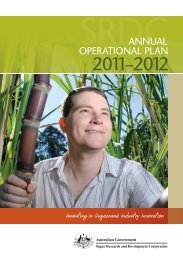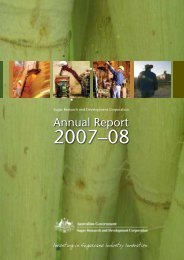Section 2 - Sugar Research and Development Corporation
Section 2 - Sugar Research and Development Corporation
Section 2 - Sugar Research and Development Corporation
Create successful ePaper yourself
Turn your PDF publications into a flip-book with our unique Google optimized e-Paper software.
48<br />
<strong>Section</strong> 3<br />
HIGHLIGHTS OF RESEARCH PORTFOLIO<br />
The SRDC investment portfolio produced some very strong outcomes<br />
in 2010–2011 with research results being diverse <strong>and</strong> positive.<br />
Industry Overview –<br />
Southern Region<br />
This year was an exciting time for R&D projects<br />
in the south as several projects generated from<br />
the southern region with industry-wide impact<br />
were completed.<br />
The most signifi cant was ‘Accelerating the<br />
adoption of best practice nutrient management<br />
in the Australian <strong>Sugar</strong> Industry’, which<br />
developed <strong>and</strong> validated the SIX EASY STEPS<br />
nutrient management package.<br />
The project provided an opportunity to promote<br />
<strong>and</strong> accelerate the adoption of best-practice<br />
nutrient management across the Australian<br />
sugarcane industry—of paramount importance<br />
since the introduction of the Queensl<strong>and</strong><br />
Government’s reef protection regulations.<br />
Another project offering industry-wide benefi t<br />
was ‘Establishing the second crop cycle into<br />
permanent beds’ that assisted growers to<br />
establish the second cane-cropping cycle<br />
onto permanent beds with appropriate bed<br />
maintenance <strong>and</strong> retention of undisturbed crop<br />
residues to maintain soil structure <strong>and</strong> biology.<br />
The project assessed a variety of tillage practices<br />
to establish a second crop cycle <strong>and</strong> showed<br />
that all treatments produced good yields in<br />
the right conditions <strong>and</strong> demonstrated that<br />
minimum tillage systems could offer signifi cant<br />
cost savings.<br />
Nutgrass is a particular weed problem in the<br />
cane growing areas of northern NSW causing<br />
poor germination <strong>and</strong> reduced growth of young<br />
plants <strong>and</strong> ratoon crops. Previous attempts<br />
to control outbreaks were ad hoc with no<br />
satisfactory structured control package available.<br />
<strong>Research</strong> project ‘Integrated nutgrass control<br />
in NSW’ showed a substantial economic benefi t<br />
for growers by who control nutgrass in cane<br />
by adopting a long-term integrated approach<br />
to reduce the number of viable tubers.<br />
A publication, ‘Managing Nutgrass in Cane’,<br />
was produced for growers.<br />
SRDC Annual Report 2010–2011<br />
<strong>Research</strong> <strong>and</strong> development is synonymous with<br />
unpredictability. Some projects, while unable to<br />
produce the desired output this year did, however,<br />
advance the information base for future research.<br />
‘Better frost tolerant varieties for NSW’ led by<br />
the NSW Farming Systems Group is a good<br />
example. Frost damage to sugarcane crops affects<br />
about one third of the NSW cane growing l<strong>and</strong>s<br />
reducing production <strong>and</strong> costing the industry up<br />
to $2.5 million in about one in three years. This<br />
research tested whether artifi cial freeze testing of<br />
cane seedlings could identify varieties that would<br />
perform well under fi eld frosting conditions.<br />
The trials showed that it is diffi cult to clearly<br />
correlate ratings derived by artifi cial freeze testing<br />
of seedlings with known fi eld reaction of more<br />
mature cane plants. The degree of differentiation<br />
between the good, average <strong>and</strong> poor categories<br />
was very small <strong>and</strong> the majority of individual trials<br />
failed to show any statistical signifi cance. Further<br />
work may be able to refi ne the techniques, but<br />
at this stage it’s not reliable enough to use in<br />
recommendations to farmers on frost tolerance.<br />
A project with particular application to the south<br />
this year was ‘Restoring Effi ciency to Harvested<br />
Cane Transport in New South Wales’. At the<br />
beginning of the 2007 harvesting season no<br />
operator in NSW could consistently load 23.5<br />
tonnes of whole of crop material into the new<br />
bins. This necessitated more trips to the mill,<br />
which signifi cantly lowered transport effi ciency<br />
<strong>and</strong> increased the cost of fuel to the cogeneration<br />
plants. <strong>Research</strong>ers investigated ways to compact,<br />
rather than compress, material into the bins <strong>and</strong><br />
increase bulk density during loading. The project<br />
developed a pronged rake aligner <strong>and</strong> achieved<br />
an impressive load of 23.26 tonnes net. However<br />
evaluation found the system was labour intensive<br />
<strong>and</strong> slow for a commercial harvesting operation<br />
on a medium to high daily quota.<br />
Next year, projects assessing variety performance<br />
on different row spacing, the use of near infrared<br />
(NIR) to rate variety resistance to smut <strong>and</strong><br />
Fiji Leaf Gall diseases, <strong>and</strong> a streamlined life cycle<br />
assessment tool will be completed.






